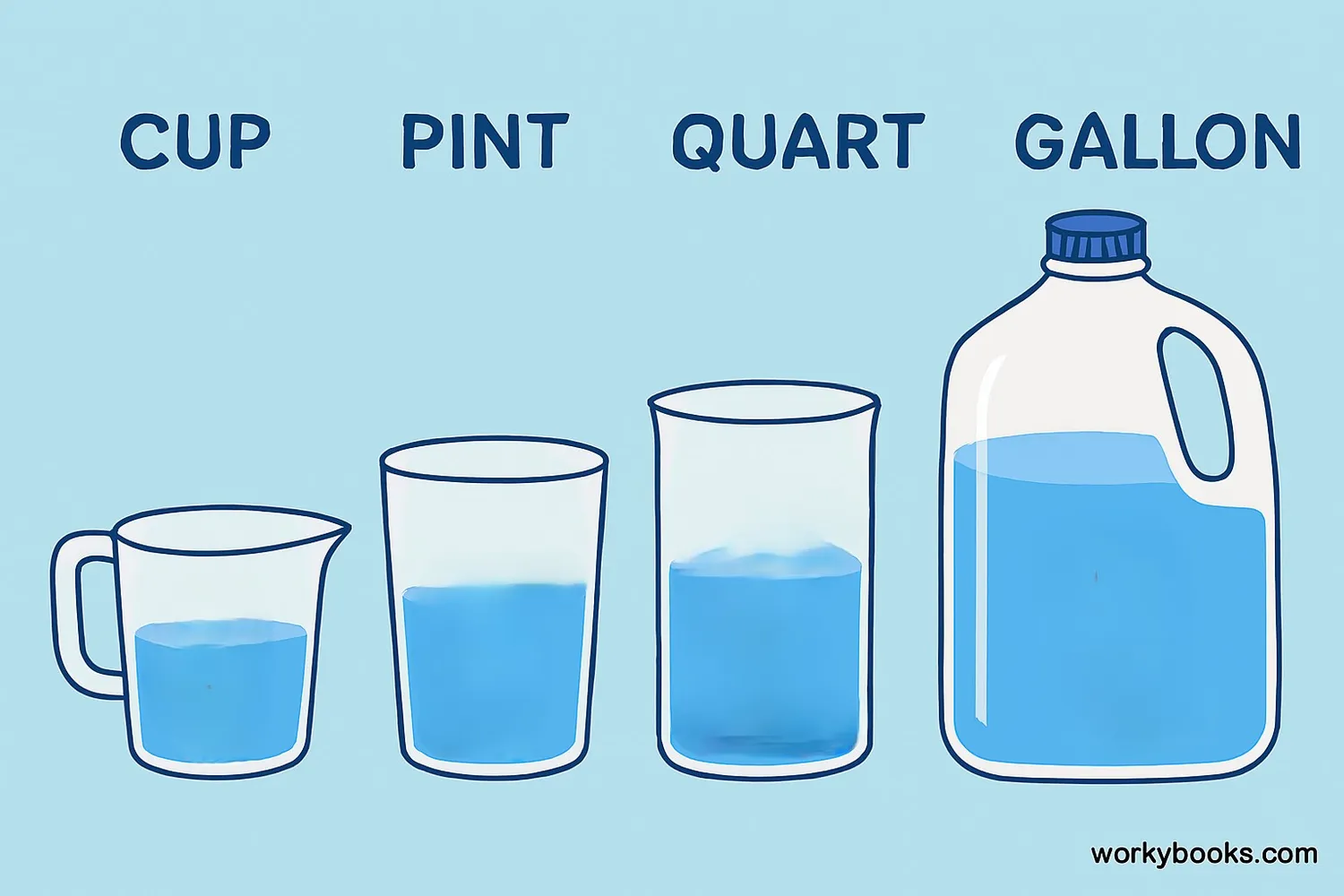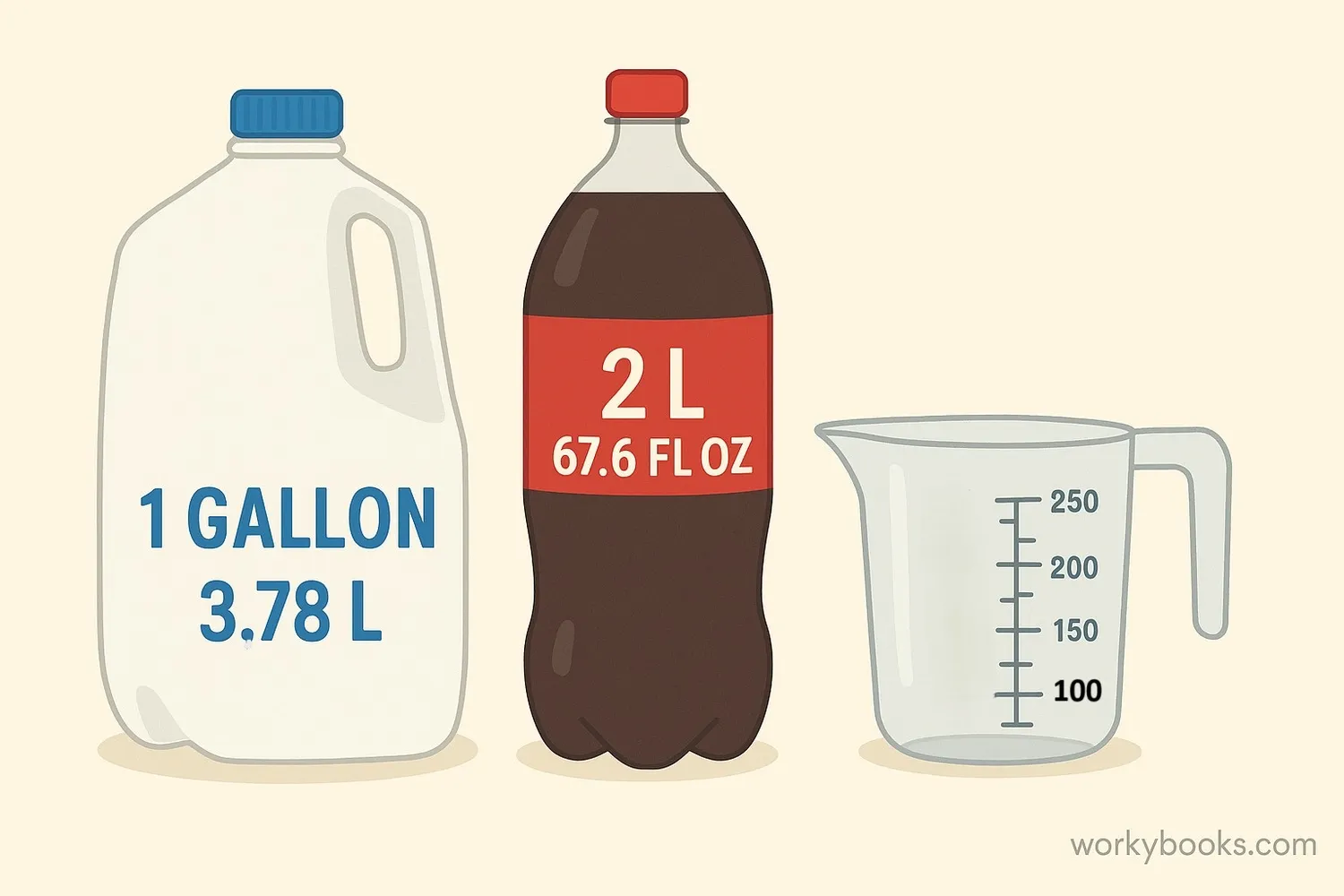Liquid Measurement Chart - Definition, Examples, Quiz, FAQ, Trivia
Learn to measure liquids using customary and metric units with easy explanations and practice activities
What is Liquid Measurement?

Liquid measurement means finding how much space a liquid takes up. We use special units to measure liquids, just like we use inches and feet to measure length. There are two main systems for measuring liquids: the customary system (used mainly in the United States) and the metric system (used in most other countries).
Why is liquid measurement important? We use it in cooking, science experiments, medicine, and many everyday activities. Understanding how to measure liquids helps us follow recipes correctly, take the right amount of medicine, and conduct scientific experiments accurately.
Liquid measurements have special names. In the customary system, we use teaspoons, tablespoons, fluid ounces, cups, pints, quarts, and gallons. In the metric system, we use milliliters, centiliters, deciliters, and liters.
Key Concept
Liquid measurement tells us the volume of a liquid - how much space it takes up. Different measurement systems use different units.
Customary Units of Liquid Measurement
The customary system is used mainly in the United States for everyday measurements. Here are the most common units for measuring liquids:
Conversion Relationships
Remembering these relationships helps with converting between units.
Remember
A gallon is the largest common customary unit for liquids. A standard milk jug contains 1 gallon of milk.
Metric Units of Liquid Measurement
The metric system is used by most countries around the world and is based on units of 10. This makes conversions very straightforward. The basic unit for measuring liquids in the metric system is the liter.
Metric Conversion
To convert between metric units, simply move the decimal point left or right.
Remember
A liter is slightly more than a quart. A standard soda bottle contains 2 liters of liquid.
Conversion Charts
Conversion charts help us change measurements from one unit to another. Here are useful charts for converting between customary and metric liquid measurements:
Customary to Metric Conversion
| Customary Units | Metric Equivalent |
|---|---|
| 1 teaspoon | 4.93 milliliters |
| 1 tablespoon | 14.79 milliliters |
| 1 fluid ounce | 29.57 milliliters |
| 1 cup | 236.59 milliliters |
| 1 pint | 473.18 milliliters |
| 1 quart | 0.95 liters |
| 1 gallon | 3.79 liters |
Metric to Customary Conversion
| Metric Units | Customary Equivalent |
|---|---|
| 1 milliliter | 0.034 fluid ounces |
| 10 milliliters | 0.34 fluid ounces |
| 100 milliliters | 3.38 fluid ounces |
| 250 milliliters | 1.06 cups |
| 500 milliliters | 2.11 cups |
| 1 liter | 4.23 cups |
| 1 liter | 2.11 pints |
| 1 liter | 1.06 quarts |
| 4 liters | 1.06 gallons |
Chart Tip
For quick estimations: 1 cup is about 250 mL, 1 quart is about 1 liter, and 1 gallon is about 4 liters.
Real-World Examples

Let's practice liquid measurement with some real-world examples:
Example 1: A recipe calls for 2 cups of milk. How many milliliters is this?
Solution: 2 cups × 236.59 mL/cup ≈ 473 mL
Example 2: A water bottle contains 500 mL of water. How many cups is this?
Solution: 500 mL ÷ 236.59 mL/cup ≈ 2.1 cups
Example 3: A car's gas tank holds 15 gallons of gasoline. How many liters is this?
Solution: 15 gallons × 3.79 liters/gallon ≈ 56.85 liters
Example 4: A medicine dosage is 2 teaspoons. How many milliliters is this?
Solution: 2 teaspoons × 4.93 mL/teaspoon ≈ 9.86 mL
Practice converting measurements you see on packaging - soda bottles, milk containers, and medicine bottles often show both measurement systems!
Conversion Tip
When cooking, remember that 1 tablespoon equals 3 teaspoons, and 1 cup equals 16 tablespoons.
Liquid Measurement Quiz
Test your measurement knowledge with this 5-question quiz. Choose the correct answer for each question.
Frequently Asked Questions
Here are answers to common questions about liquid measurement:
Measurement Trivia
Discover interesting facts about liquid measurement:
Origin of the Gallon
The gallon was originally defined as the volume of 8 pounds of wheat. Later, it was redefined as the volume of 8 pounds of wine. This historical definition explains why there are both US gallons and imperial gallons (used in the UK).
Water's Special Property
Water has a unique property: 1 milliliter of water weighs exactly 1 gram and occupies exactly 1 cubic centimeter of space. This relationship makes conversions between volume and weight easy when working with water.
World's Largest Measurement
The largest unit of liquid measurement in the metric system is the kiloliter (1,000 liters). But even larger units exist, like the megaliter (1,000,000 liters) used for measuring reservoir capacities. The largest reservoir in the US, Lake Mead, can hold about 32,000 megaliters of water when full.
Cooking Measurements
Standard measuring cups and spoons were invented by Fannie Farmer in 1896. Before this, recipes used vague measurements like "a handful" or "a pinch." Her book, "The Boston Cooking-School Cook Book," revolutionized cooking by introducing precise measurements.


